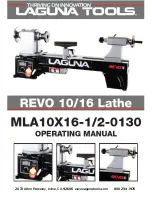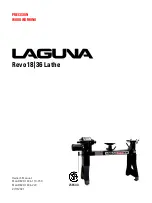
-30-
D('+09\eZ_kfgCXk_\D]^%J`eZ\/&'0
FG
<
I
8
K@FEJ
Cutting Speeds for High Speed Steel
(HSS) Cutting Tools
Workpiece Material
Cutting Speed
(sfm)
Aluminum & alloys
300
Brass & Bronze
150
Copper
100
Cast Iron, soft
80
Cast Iron, hard
50
Mild Steel
90
Cast Steel
80
Alloy Steel, hard
40
Tool Steel
50
Stainless Steel
60
Titanium
50
Plastics
300-800
Wood
300-500
Note:
=fiZXiY`[\Zlkk`e^kffcj#[flYc\
k_\Zlkk`e^jg\\[%K_\j\mXcl\jXi\X
^l`[\c`e\fecp%
Refer to the
MACHINERY'S
HANDBOOK
for more detailed informa-
tion.
Setting RPM
To determine and set the needed cutting RPM, do
these steps:
1.
Use the table in
Figure 31
to determine the cutting
speed required for the workpiece material.
2.
Determine the average final diameter of the
workpiece in inches, for the cut to be made.
3.
Now use the following formula to determine the
closest RPM for the cutting operation:
(Cutting Speed x 4)
Diameter of Cut
4.
With the calculated RPM, refer to the
RPM Chart
on
Page 31
and select the pulley ratio that gives you
the closest RPM to what you need.
5.
DISCONNECT THE LATHE FROM POWER!
6.
Release the belt tension lever (
Figure 32
).
7.
Make sure the spindle is completely stopped
and then open the belt access door (
Figure 33
).
8.
Move the belt to the appropriate pulley combination
that is closest to your calculated RPM. In the chart
for example, 300 RPM is needed so BC2 is selected:
9.
Close the door and re-tension the belt.
=`^li\
31
%
Cutting speed table for HSS
cutting tools.
= RPM
=X`cli\kf]fccfnIGDXe[]\\[iXk\^l`[\c`e\jdXp
k_i\Xk\efg\iXkfijX]\kp]ifd\a\Zk\[gXikjfiYif$
b\ekffcj%
Figure 33.
Belt and change gear access.
Figure 32.
Belt tension lever.
All manuals and user guides at all-guides.com






































